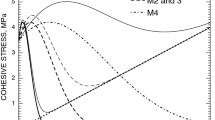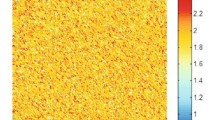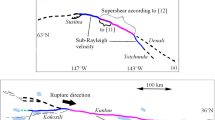Abstract—The formation of supershear rupture (with a slip front propagation velocity higher than S-wave velocity in the material) along a model fault with homogeneous and heterogeneous surface is analyzed based on the results of numerical simulation. Heterogeneity of the properties is specified by friction spots weakening at shear, interspersed with stable friction segments between them. This problem statement goes back to the well-known asperity model (Kanamori and Stewart, 1978). In this paper, we use seismological and geodetic data to estimate characteristic sizes of the fault-zone segments that are locked during interseismic period. Calculations show that the characteristic sizes of inhomogeneities on the slip plane largely determine the pattern of dynamic rupture propagation. A necessary condition for rupture to pass into supershear is a sufficiently rapid frictional weakening. The observed wavefield features (relatively weak attenuation, an increase in the amplitude of oscillations at some distance from the hypocenter, the predominant motion in the direction parallel to the fault, etc.) do not necessarily need nonlinear medium and are not the result of generation of a “shock wave,” as assumed in some publications, but are only a result of wavefront interference. Interaction between regions with different frictional properties can cause rupture transition to supershear, induce dynamic slip pulses which re-fracture the fault segments previously displaced by the creep process, and slowdown rupture propagation. Judging by the results of calculations, rupture is more likely to accelerate into supershear on rough/undulating segments of contact surfaces with closely spaced frictional weakening zones. At the same time, propagation of such a rupture with a decaying displacement amplitude can be stable on locally smoother segments.










Similar content being viewed by others
REFERENCES
Andrews, D.J., Rupture velocity for plane strain shear cracks, J. Geophys. Res., 1976, vol. 81, no. 32, pp. 5679–5687.
Arkhipov, V.N., Borisov, V.A., Budkov, A.M., et al., Mekhanicheskoe deistvie yadernogo vzryva (Mechanical Action of a Nuclear Explosion), Moscow: Fizmatlit, 2003.
Bao, H., Ampuero, J.-P., Meng, L., Fielding, E.J., Liang, C., Milliner, C.W.D., Feng, T., and Huang, H., Early and persistent supershear rupture of the 2018 magnitude 7.5 Palu earthquake, Nat. Geosci., 2019, vol. 12, pp. 200–205. https://doi.org/10.1038/s41561-018-0297-z
Batukhtin, I.V., Budkov, A.M., and Kocharyan, G.G., Rupture nucleation and arrest on faults with a heterogeneous surface, Mater. V Mezhdun. konf. “Triggernye effekty v geosistemakh” (Proc. V Int. Conf. “Trigger Effects in Geosystems”), Adushkin, V.V. and Kocharyan, G.G., Eds., Moscow, 2019, Moscow: TORUS, 2019, pp. 137–149.
Bhat, H.S., Supershear Earthquakes. Theory. Experimenrs. Observations, Self published, 2020. https://harshasbhat. github.io/files/Bhat2021a.pdf.
Bodin, P. and Horton, S., Source parameters and tectonic implications of aftershocks of the Mw 7.6 Bhuj earthquake of 26 January 2001, Bull. Seismol. Soc. Am., 2004, vol. 94, no. 3, pp. 818–827.
Bouchon, M. and Vallee, M., Observation of long supershear rupture during the magnitude 8.1 Kunlunshan earthquake, Science, 2003, vol. 301, no. 5634, pp. 824–826. https://doi.org/10.1126/science.1086832
Bouchon, M., Bouin, M.P., Karabulut, H., Toksoz, M.N., Dietrich, M., and Rosakis, A.J., How fast is rupture during an earthquake? New insights from the 1999 Turkey earthquakes, Geophys. Res. Lett., 2001, vol. 28, no. 14, pp. 2723–2726. https://doi.org/ 2001GL013112
Bouchon, M., Karabulut, H., Bouin, M.-P., Schmittbuhl, J., Vallée, M., Archuleta, R., Das, S., Renard, F., and Marsan, D., Faulting characteristics of supershear earthquakes, Tectonophysics, 2010, vol. 493, pp. 244–253. https://doi.org/10.1016/j.tecto.2010. 06.011
Brace, W.F. and Byerlee, J.D., Stick-slip as a mechanism for earthquakes, Science, 1966, vol. 153, no. 3739, pp. 990–992.
Bruhat, L., Fang, Z., and Dunham, E.M., Rupture complexity and the supershear transition on rough faults, J. Geophys. Res.: Solid Earth, 2016, vol. 121, pp. 210–224. https://doi.org/10.1002/2015JB012512
Burridge, R., Admissible speeds for plane-strain self-similar shear cracks with friction but lacking cohesion, Geophys. J. Int., 1973, vol. 35, no. 4, pp. 439–455.
Chen, X., Carpenter, B.M., and Reches, Z., Asperity failure control of stick-slip along brittle faults, Pure Appl. Geophys., 2020, vol. 177, pp. 3225–3242. https://doi.org/10.1007/s00024-020-02434-y
Chinnery, M.A., The strength of the Earth’s crust under horizontal shear stress, J. Geophys. Res., 1964, vol. 69, pp. 2085–2089.
Chouneta, A., Valléea, M., Causseb, M., and Courboulex, F., Global catalog of earthquake rupture velocities shows anticorrelation between stress drop and rupture velocity, Tectonophysics, 2018, vol. 733, no. 9, pp. 148–158. https://doi.org/10.1016/j.tecto.2017.11.005
Das, S., Supershear earthquake ruptures-theory, methods, laboratory experiments and fault superhighways: an update, in Perspectives on European Earthquake Engineering and Seismology, vol. 2, Ansal, A., Ed., Cham: Springer, 2015, pp. 1–20. https://doi.org/10.1007/978-3-319-16964-4\_1
Dunham, E.M. and Archuleta, R.J., Evidence for a supershear transient during the 2002 Denali fault earthquake, Bull. Seismol. Soc. Am., 2004, vol. 94, no. 6, pp. S256–S268. https://doi.org/10.1785/0120040616
Ellsworth, W.L., Celebi, M., Evans, J.R., Jensen, E.G., Kayen, R., Metz, M.C., Nyman, D.J., Roddick, J.W., Spudich, P., and Stephens, C.D., Near-field ground motion of the 2002 Denali fault, Alaska, earthquake recorded at pump station 10, Earthquake Spectra, 2004, vol. 20, pp. 597–615. https://doi.org/10.1193/1.1778172
Haeussler, P.J., Schwartz, D.P., Dawson, T., Stenner, H., Lienkaemper, J., Sherrod, B., Cinti, F., Montone, P., Craw, P., Crone, A., and Personius, S.F., Surface rupture and slip distribution of the Denali and Totschunda faults in the 3 November 2002 M 7.9 earthquake, Alaska, Bull. Seismol. Soc. Am., 2004, vol. 94, pp. S23–S52. https://doi.org/10.1785/0120040626
Ikari, M.J., Marone, C., Saffer, D.M., and Kopf, A.J., Slip weakening as a mechanism for slow earthquakes, Nat. Geosci., 2013, vol. 6, pp. 468–472. https://doi.org/10.1038/NGEO18198
Ji, C., Wald, D.J., and Helmberger, D.V., Source description of the 1999 Hector Mine, California earthquake, Part I: Wavelet domain inversion theory and resolution analysis, Bull. Seismol. Soc. Am., 2002, vol. 92, no. 4, pp. 1192–1207.
Ji, C., Helmberger, D.V., Wald, D.J., and Ma, K.F., Slip history and dynamic implications of the 1999 Chi-Chi, Taiwan, earthquake, J. Geophys Res., 2003, vol. 108, no. B9, Paper ID 2412.
Kanamori, H. and Stewart, G.S., Seismological aspects of the Guatemala earthquake of February 4, 1976, J. Geophys. Res., 1978, vol. 83, no. B7, pp. 3427–3434.
Kocharyan, G.G., Geomekhanika razlomov (Geomechanics of Faults), Moscow: GEOS, 2016.
Kocharyan, G.G. and Kishkina, S.B., The physical mesomechanics of the earthquake source, Phys. Mesomech., 2021, vol. 24, no. 4, pp. 343–356. https://doi.org/10.1134/S1029959921040019
Kocharyan, G.G. and Ostapchuk, A.A., The influence of viscosity of thin fluid films on the frictional interaction mechanism of rock blocks, Dokl. Earth Sci., 2015, vol. 463, no. 1, pp. 757–759.
Kocharyan G.G. and Ostapchuk, A.A., Mesostructure of tectonic fault slip zone, Fiz. Mezomekh., (in press).
Liu, C., Bizzarri, A., and Das, S., Progression of spontaneous in-plane shear faults from sub-Rayleigh to compressional wave rupture speeds, J. Geophys. Res., 2014, vol. 119, pp. 8331–8345. https://doi.org/10.1002/2014JB011187
Matsuzawa, T., Igarashi, T., and Hasegawa, A., Characteristic small-earthquake sequence off Sanriku, Northeastern Honshu, Japan, Geohpys. Res. Lett., 2002, vol. 29, no. 11, Paper ID 1543. https://doi.org/10.1029/2001GL014632
Metois, M., Vigny, C., and Socquet, A., Interseismic coupling, megathrust earthquakes and seismic swarms along the Chilean subduction zone (38°–18° S), Pure Appl. Geophys., 2017, vol. 173, no. 5, pp. 1431–1449. https://doi.org/10.1007/s00024-016-1280-5
Mikhailov, V.O., Timoshkina, E.P., Smirnov, V.B., Khairetdinov, S.A., and Dmitriev, P.N., On the origin of postseismic deformation processes in the region of the Maule, Chile earthquake of February 27, 2010, Izv., Phys. Solid Earth, 2020, vol. 56, no. 6, pp. 762–771.
Moore, D.E. and Lockner, D.A., Friction of the smectite clay montmorillonite: A review and interpretation of data, in The Seismogenic Zone of Subduction Thrust Faults, Dixon, T.H. and Moore, J.C., Eds., New York: Columbia Univ. Press, 2007, pp. 317–345. http://cup.columbia.edu/book/the-seismogenic-zone-of-subduction-thrust-faults/9780231138666.
Noda, H., Lapusta, N., and Kanamori, H., Comparison of average stress drop measures for ruptures with heterogeneous stress change and implications for earthquake physics, Geophys. J. Int., 2013, vol. 193, no. 3, pp. 1691–1712. https://doi.org/10.1093/gji/ggt074
Okada, T., Matsuzawa, T., and Hasegawa, A., Comparison of source areas of M4.8+ or –0.1 repeating earthquakes off Kamaishi, NE Japan; are asperities persistent features?, Earth Planet. Sci. Lett., 2003, vol. 213, nos. 3–4, pp. 361–374.
Pavlenko, O.V., Shock waves as a possible mechanism of generation of abnormally high accelerations during the M 9.0 Tohoku earthquake on March 11, 2011, Dokl. Earth Sci., 2019, vol. 484, no. 1, pp. 71–75.
Psakhie, S.G., Shilko, E.V., Popov, M.V., and Popov, V.L., Key role of elastic vortices in the initiation of intersonic shear cracks, Phys. Rev. E, 2015, vol. 91, no. 6, Paper ID 063302. https://doi.org/10.1103/PhysRevE.91.063302
Roesner, A., Ikari, M.J., Saffer, D.M., Stanislowski, K., Eijsink, A.M., and Kopf, A.J., Friction experiments under in-situ stress reveal unexpected velocity-weakening in Nankai accretionary prism samples, Earth Planet. Sci. Lett., 2020, vol. 538, Paper ID 116180. https://doi.org/10.1016/j.epsl.2020
Rudenko, O.V. and Makov, Yu.N., Sonic boom: from the physics of nonlinear waves to acoustic ecology (a review), Acoust. Phys., 2021, vol. 67, no. 1, pp. 1–25. https://doi.org/10.31857/S0320791921010032
Scholz, C.H., Paradigms or small change in earthquake mechanics, Ch. 21 of Fault Mechanics and Transport Properties of Rocks: A Festschrift in Honor, vol. 51, Brace, W.F., Evans, B., and Wang, T., Eds., London: Academic Press, 1992, pp. 505–517.
Scholz, C.H., The Mechanics of Earthquakes and Faulting, 3rd ed., Cambridge: Cambridge Univ. Press, 2019.
Shao, G.F., Li, X.Y., Ji, C., and Maeda, T., Focal mechanism and slip history of the 2011 Mw 9.1 off the Pacific coast of Tohoku Earthquake, constrained with teleseismic body and surface waves, Earth, Planets Space, 2011, vol. 63, no. 7, pp. 559–564.
Stefanov, Yu.P., Initiation and propagation of rupture in the fault zone, Fiz. Mezomekh., 2008, vol. 11, no. 1, pp. 94–100.
Timoshenko, S.P. and Goodier, J.N., Theory of Elasticity, 3rd ed., New York: McGraw-Hill, 1970.
Turcotte, D.L. and Schubert, G., Geodynamics. Application of Continuum Physics to Geological Problems, New York: Wiley, 1982.
Vallée, M. and Dunham, E.M., Observation of far-field Mach waves generated by the 2001 Kokoxili supershear earthquake, Geophys. Res. Lett., 2012, vol. 39, Paper ID L05311. https://doi.org/10.1029/2011GL050725
Zhang, X., Feng, W., Du, H., Li, L., Wang, Sh., Yi, L., and Wang, Y., The 2018 Mw7.5 Papua New Guinea earthquake: A dissipative and cascading rupture process, Geophys. Res. Lett., 2020, vol. 47, no. 17, Paper ID e2020GL089271. https://doi.org/10.1029/2020GL089271
Funding
The work was supported by the Russian Science Foundation (project no. 22-27-00565).
Author information
Authors and Affiliations
Corresponding author
Ethics declarations
The authors declare that they have no conflicts of interest.
Additional information
Translated by M. Nazarenko
Rights and permissions
About this article
Cite this article
Budkov, A.M., Kishkina, S.B. & Kocharyan, G.G. Modeling Supershear Rupture Propagation on a Fault with Heterogeneous Surface. Izv., Phys. Solid Earth 58, 562–575 (2022). https://doi.org/10.1134/S1069351322040012
Received:
Revised:
Accepted:
Published:
Issue Date:
DOI: https://doi.org/10.1134/S1069351322040012




